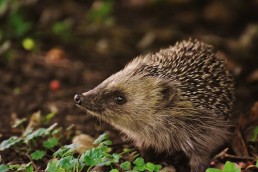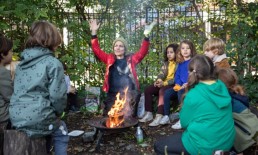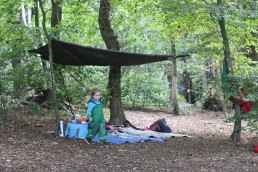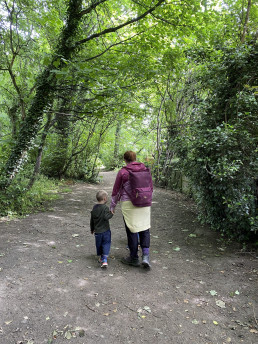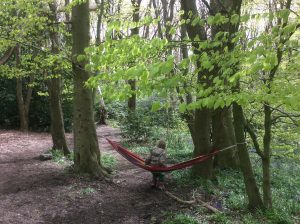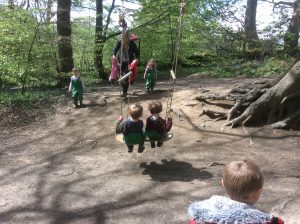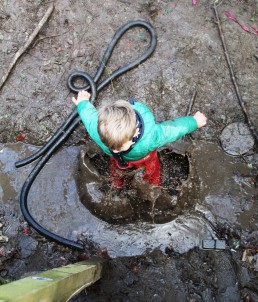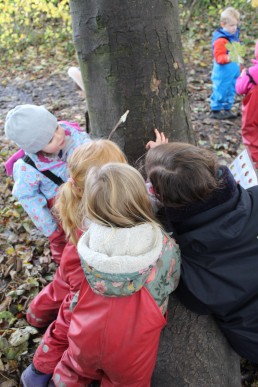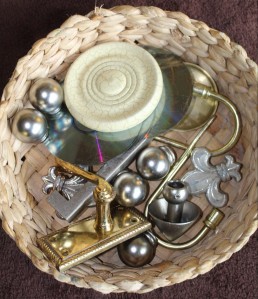Reduce Reuse Recycle

Welcome to our Inspirations Eco- school blog.
We can’t wait to share all our activities and eco-projects that will be happening in our setting.
The Early Years is a crucial time to install a love and respect for the environment in our children and
we are so lucky at Inspirations to have the perfect environment to do this. We are committed to
providing our children with a green and sustainable education.
Our Forest School is offered all year round as part of our daily pre-school activities. Between these
off-site sessions forest school activities take place on site around our veg garden, wildlife pond and
within our extensive grounds. We have implemented various eco-friendly practices to reduce our carbon footprint by encouraging reusable water bottles, recycling paper, taking part in this year’s Big Battery Hunt, and even making our own paper!
Our outdoor area is a nature inspired learning space. Our children have enjoyed making bug hotels
to provide a safe hideaway for wildlife. Our well-built hotels can shelter anything from hedgehogs to
toads, solitary bees to bumblebees, ladybirds to woodlice.
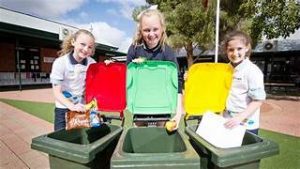
We also participated in Plant life's annual campaign No Mow May. Educating our children on the
importance of boosting flowers, and nectar, available to pollinating insects such as bees, butterflies,
and moths. This then also allows spring flowers to set seed and plants to establish themselves in
advance of the summer.
At Inspirations we believe that by introducing eco-friendly and environmental education at an early
age, we are nurturing a generation of responsible and environmentally conscious citizens. Our vision is that all our children grow up with an understanding of the impact their actions have on the planet and are developing a sense of responsibility towards it.
We are so excited to be starting our eco-school journey in the new academic year, working towards
our first Eco-Schools Green Flag. We also have a community project that we are so excited to get
involved with and can’t wait to share with you.
Together, we can make and create a greener and more sustainable future.
Tara Slade.
Looking Out For Forest Friends
Rounded body, short dark yellow-tipped spines and a short tail – is it a Gruffalo I hear you ask? No, it's the Hedgehog!
Hedgehogs are a picture of cuteness and are largely widespread throughout Britain. In the summer time they spend most of their days sheltering in moss, grass, leaves and hedges. In fact, the reason they are called 'Hedge' hogs is because of where they build and nestle in hedges, bushes and shrubs. The ‘hog’ part comes from the small snorting and grunting sounds they make, which is similar to a pig.
There are a few facts about Hedgehogs, for example;
- They are nocturnal
- They can hibernate
- There are 15 species of hedgehog
- They have 5000 spikes
- Their snout is long to help them forage for food, such as worms, insects and berries
- They are lactose intolerant
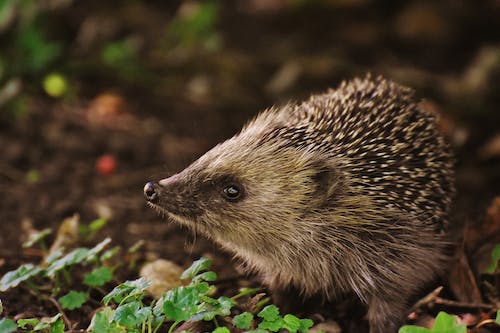 Hedgehogs tend to forage in the evening and can travel for up to 2 miles, that’s a long way for little legs! They are known for being a Gardeners’ Friend and have earned this reputation because of their eating habits. Not only do they enjoy berries and fruit but the staple of their diet is made up from pests that are common in our back gardens such as beetles and caterpillars. This helps preserve the
Hedgehogs tend to forage in the evening and can travel for up to 2 miles, that’s a long way for little legs! They are known for being a Gardeners’ Friend and have earned this reputation because of their eating habits. Not only do they enjoy berries and fruit but the staple of their diet is made up from pests that are common in our back gardens such as beetles and caterpillars. This helps preserve the
fruit and vegetables you may have growing in your gardens.
Vulnerable to Extinction
Sadly, Hedgehogs are at risk, so much so that they are classified as ‘vulnerable to extinction’ and are on Britain’s red list for mammals due to the sharp rate of it’s decline. Hedgehogs are one of the oldest mammals on the planet. They are Britain’s only spined mammal and a national favourite. But their numbers have fallen from over 30 million in the 1950s to less than one million today. More and more is being done to stop these spiky little creatures from becoming extinct. Recently The British Hedgehog Preservation Society ran a successful campaign to ensure that all new housing developments include hedgehog highways. This will help to give hogs the room they need to roam and find food and suitable mates. https://www.countryliving.com/uk/wildlife/countryside/a28604641/hedgehogs-building-rules
A garden can be a haven for Hedgehogs but decking, astroturf, gravel and paving, as well as neat cut back grass with no trees or bushes aren’t much use to our prickly friends. Such things as pesticides not only kill the bugs that they eat but also get into the Hedgehogs diet, causing them to become ill. Therefore, the introduction of Wildlife gardening is helping to maintain these habitable havens and is aimed at creating an environment that is attractive to various forms of wildlife such as Hedgehogs. The move towards this form of gardening and the great work done by the Hedgehog Street campaign has shown that even though there is still a decline in the countryside, in urban and suburban areas things are looking better. Thankfully this means that more and more gardens up and down the country are becoming hedgehog friendly. Is your garden Hedgehog friendly? There is one way you can help...
Get your own hedgehog highway!
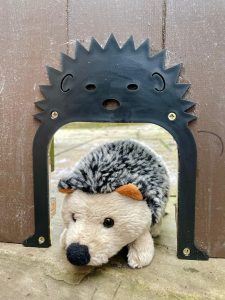
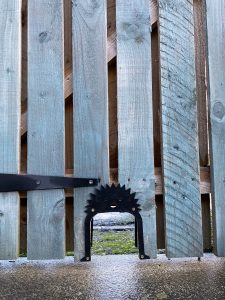
Let's open up our gardens again, to get your own Hedgehog Highway contact Handyman Ian local to the area. He will cut a hole in your fencing and attach a hedgehog frame just like this one for £12
Email: https://www.facebook.com/handyian84 Whatsapp:+44 7740 328619
Get involved in making your garden hedgehog friendly and perhaps we can work together to save this species from extinction.
- Ashleigh
Forest School in the News
It's becoming more common to find Forest School articles making the news and for all the right reasons. Out of the turmoil of lock down came some good news stories, and here is one that we wanted to share with you.
Lockdowns were “a chance to get off the treadmill” for families, says Lewis Ames, co-director of Devon-based forest school Children of the Forest. They’ve seen a rise in applications since the start of the pandemic, with about 150 families on their toddler-group waiting list, and 50-60 children on the waiting list for their forest school for home-educated children.
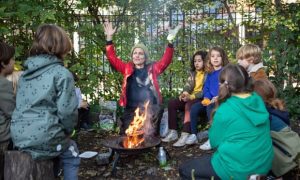
Autumn Equinox
As the yellow takes over the green of the leaves, the Pre-School children get ready for a full day in the woods to celebrate the end of summer. We take a bag of sandwiches, oatcakes, veggie sticks, plenty of fruit and some hot chocolate.
During the autumnal equinox, the sun shines directly on the equator, and the northern and southern hemispheres get the same amount of rays. The alignment officially occurs at 2:21 p.m. Wednesday, around the exact time we were laying on our backs looking up at the trees.
We were there to celebrate change, to appreciate the natural surroundings, the end of summer, and freedom and time to learn from our woods. I brought my camera along to capture some of the children at play-
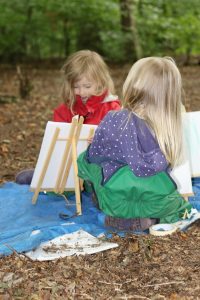
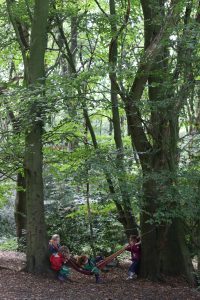
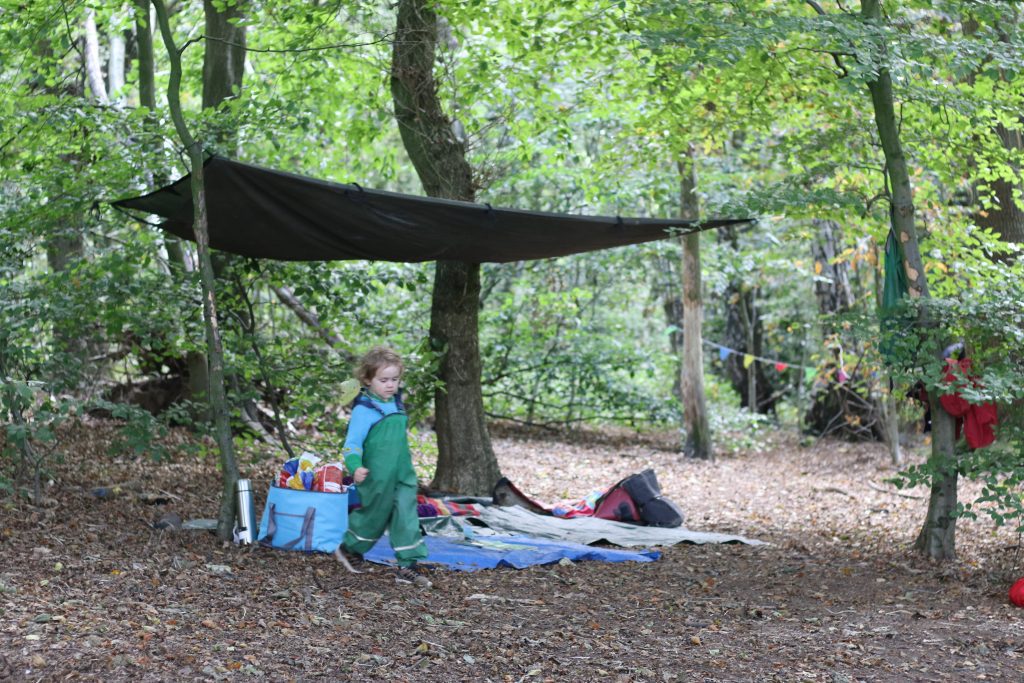
Summer Solstice
It was the longest day of the year on Monday, also known as Summer Solstice. A day we weren't going to allow to slip past us without making the very best of it.
Summer Solstice occurs when one of the Earth's Poles has its maximum tilt toward the Sun, and so naturally we spent the whole day outdoors.
Usually for our Pre-Schoolers our Forest School sessions come back to the Yurt for lunch, before taking another group session in the afternoon. But this Wednesday we took lunch with us and spent the whole day in the forest.
It was beautiful.
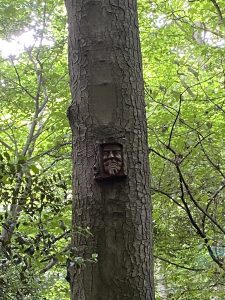
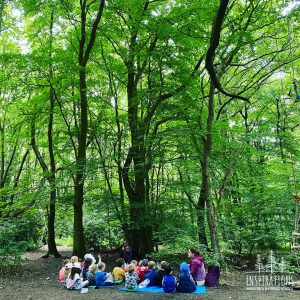
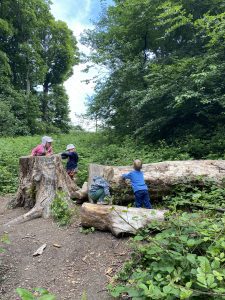
Its amazing to see how the environment shapes behaviour and guides play. Spending the whole day in the woods allowed the children the freedom of both space and time without us having to cut short their explorations.
As we entered the woods a little boy at the front ran ahead, I was just about to call him back when I realised he was running to a particular tree simply to wrap his arms around it.
Nature Appreciation
As he held this embrace it occurred to me that this boy was excited to be reunited with a tree, and how wonderful that is.
How often do we remember to be thankful for plants and trees growing around us? I sure learnt something in that moment.
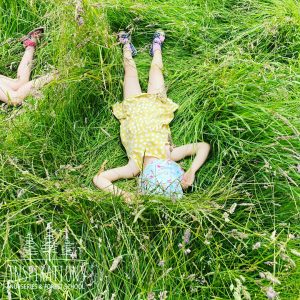
They needed this time.
They had their lunch beneath the trees, played in the hammock and rope swing, collected sticks to create dens, made their own books and explored at their own pace. At the end of the day we played in the long grass, and finished with a Nature Appreciation Story.
Then we headed back to nursery much dirtier, but calmer, wiser and more thankful of the world around us.
'Hello friends, I can see all of the sunshine in you'
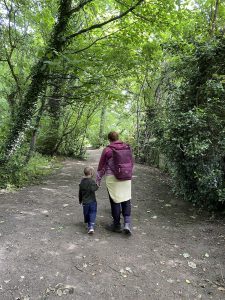
Spring Time in the Forest
A time for adaptation and growth.
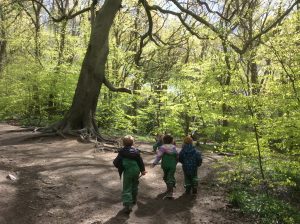
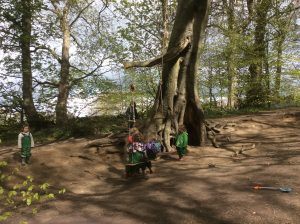
"The stream is following us."
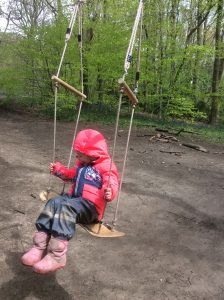 Our adventures into Hunger Hills Woods continue to inspire us all and recently we have discovered a new favourite hide out. In our "fairy tree" a local toy shop has installed a skateboard swing which the children love to play on. The surrounding area is equally awe-inspiring with an existing 'twig-wam', a large fallen Rowan tree and a stunning new growth of Beech trees which, since coming into leaf provide a wash of yellow and green light across the glade.
Our adventures into Hunger Hills Woods continue to inspire us all and recently we have discovered a new favourite hide out. In our "fairy tree" a local toy shop has installed a skateboard swing which the children love to play on. The surrounding area is equally awe-inspiring with an existing 'twig-wam', a large fallen Rowan tree and a stunning new growth of Beech trees which, since coming into leaf provide a wash of yellow and green light across the glade.Toddler's Forest School Garden
Measured Risks and The Great Outdoors
Getting outdoors could not be more important right now, and the health benefits that come with it are not only beneficial but fundamental to our wellbeing. But are the youngest members of our society getting enough outdoor adventurous play? Recent studies suggest not. 85% of parents admit they would like their children to have more adventure, whilst 44% admit they played outside more as a child then their own children do. Indeed this is a sign of the times and sometimes children miss out on these opportunities due to safety worries.

At Inspirations you can rest assured that your children are getting more than their fair share of outdoor play. Our outdoor areas are of equal, if not more importance to our indoor spaces. The 2-3 age group is where our children are first introduced to a designated forest school area in addition to their outdoor area.
Our toddler room garden is an extension of their classroom, filled with repurposed objects and areas that support the many types of schemas as mentioned in the previous blog. There are balancing beams, planks, crates, small world areas to support interests, and many more. It is here we make use of the larger loose parts and ambiguous resources such as milk crates, planks and go kart wheels. We have an open doors policy so in all weathers our toddlers have access to the outdoors.
Raising Confident Learners
Not all children have easy access to nature, so it's important we offer this space from a young age. But why is it important for young children to experience adventurous play?
In 2019 we gained planning permission to extend our toddler room garden and build a Forest School Area. This zone is opened up with increased staffing and introduces the children to more adventurous play, with tracks, steps, netting, hills and trees to explore and climb.
Providing this access opens up valuable experiences they may not get elsewhere. As their brains are forming, growing and changing every minute these measured risks they are exposed to supports healthy boundaries and emotional and physical development. This purpose built area means children are using core muscles, with hills to mount and areas to climb. The uneven ground tests and strengthens their vestibular balance skills and coordination.
Whilst children navigate this recently developed area we encourage them to safely create their own boundaries, trial ways of movement, and learn to just keep trying. Instead of suggesting how to use the area, we as educators will avoid giving direction but instead ask open ended questions. 'I wonder where you'll go next?' or 'wow that looked really hard, and you didn't give up'. By focusing on questions and observations rather than just praise and direction we are building our toddlers inner confidence that sets them up for life.
By creating dens between the trees, growing lavender and scaling balance beams, having this little taste of adventure prepares our toddlers for Forest School when they move to Pre-school ....and beyond.






Every Cloud...
https://www.youtube.com/watch?v=6AAcMqAZlXU
I followed the children into the local woods to see what they got up to on their journey into the forest, you can watch the video on YouTube by following the link above. Unfortunately due to Covid regulations this was the last walk into the woods for a month or so, but every cloud has a silver lining. The children now have their forest school sessions on-site and it has inspired us to make the most out of what we have here.
Forest School On Site

We have added some rope swings over the stream, and a slide down to the forest school area. This week during the forest school sessions our 3 and 4 year olds have been learning how to use a pneumonic drill, they’ve made oat pancakes on the outdoor campfire and are learning how to put on their outdoor suits independently. Staying on-site during forest school has also opened up some team building opportunities and chances to talk and listen around the campfire.
‘I love every shape, every colour and every number’- James 4
It won’t be long until the children can head back into the woods, but in the mean time you’ll find them knee deep in the stream, making art against the bark of trees and mastering our new rope tyre obstacle course. Sometimes it takes a little set back to encourage you to make the absolute most out of what you already have.


The Benefits of Forest School
At Inspirations we value greatly our outdoor environments which are extensive and include the use of our local Horsforth woodland at Hunger Hills. Our passion for outdoor learning and forest school comes from a deep understanding and appreciation for the ethos. The pedagogy was developed in Sweden in the 1950’s and the approach focuses on the natural environment being utilised, not only as an area where children can blow off excess energy but more importantly where children are given the opportunity to immerse themselves in nature.

http://simonr30.sg-host.com/our-settings/forsest-school/
Forest school children develop an appreciation and deep seated love of nature and are able to explore and learn from all that the environment has to offer, at a pace that suits them.
'Lead their own Learning'
The forest school ethos allows for each individual child to lead their own learning journey. They find their own pace, interests and methods of learning and attainment that best suit them. There is no pressure, no preconceived results, no adults determining a beginning or end to their project or interest.
Adults of course play a vital role one which is supportive and patient, they build strong positive relationships which children know they can trust and count on. The Adults help children take managed risks encouraging children to consider, they ask questions and encourage with a hands-on approach which helps supports critical thinking.


Resilience and Determination
Forest school children are shown to be ahead of their peers by the time they start school at the age of five. They show confidence, are very willing to ‘have a go’ and not be deterred by failed attempts. They are resilient and eager to keep trying until they find a positive solution to a problem. It is shows they are effective problem solvers who work well within a team, exhibiting high levels of motivation and concentration to any task facing them.
The forest learning environment also creates strong communicators and gives children a deep level of understanding about the word around them. They are socially advanced, understanding feelings and consequences of their behaviour and are more likely to think before they act. Naturally children who spend time in wide open spaces where the floor is uneven, who have trees to climb and weather to navigate are more confident in their own physical abilities. They are more prone to want to be outdoors as adults and as a result are more healthier, happier individuals.


There are several studies on the benefits of forest school and outdoor learning philosophy. These studies are becoming more prevalent as the ethos has slowly become more popular. Below are a few links to the most recent studies showing the benefits mentioned in our blog above.
https://www.forestschoolassociation.org/new-research-a-longitudinal-study-on-forest-school/
- Nicola

Loose Parts
Why do we use loose parts?
Loose parts are a significant segment of our ethos at Inspirations Nurseries. Before moving away from conventional toys, we did a lot of research into the benefits of using loose parts. Several education pedagogies use loose parts. Reggio Emilia and loose parts complement each other well; we use both at Inspirations. Both philosophies support open ended play using natural resources, imagination, and creativity. When children are given opportunities to engage in free play with little adult direction, they are able to explore freely with creativity and expression, because there are no limitations or expectations.

What are Loose Parts?
Loose parts are open ended materials that can be moved around, designed, and redesigned. They create opportunities to use our imaginations and discover new ideas. Conventional toys are fixed for the one purpose they were made for, whereas loose parts are open ended and can be used for a variety of things. A plastic car can only be a car. A stick could be a magic wand or a person or you could use a number of them to make a house… the possibilities are endless. Ask any parent how long their children will play with the cardboard box a toy comes in on their birthdays. Loose parts can be found anywhere. How many of us remember going to the beach and collecting shells and stones and making patterns with them? You can find loose parts in the house, in the garden or on a walk. Loose parts include both manufactured and natural resources. These can include stones, pinecones, rings, balls, blocks, boxes, leaves and even nuts and bolts.


Endless Possibilities
For outdoor play, we provide a variety of large loose parts such as tyres of different sizes, milk crates, planks of wood, cable reels etc. In our baby rooms, we use a variety of loose parts to support schemas; we use things like curtain rings to hang on mug trees, balls to post through holes, tyres to encourage rolling. Toddlers can then use slightly smaller loose parts such as pebbles to create patterns and smaller wood slices for counting. Preschool are able to use more intricate loose parts such as beads, small tiles and items they find on forest school.
The founder of the Reggio Emilia Philosophy said...
“Children need the freedom to appreciate the infinite resources of their hands, their eyes and their ears, the resources of forms, materials, sounds and colours”.
-Kayleigh
See loose parts in action in our Pre-School room here- https://youtu.be/Nngfh6Uj-yw

